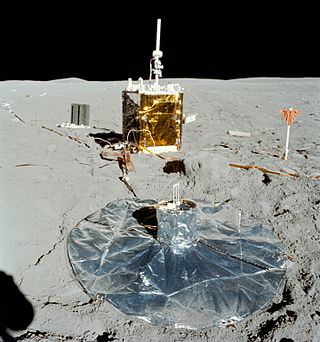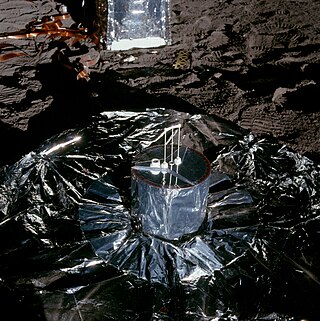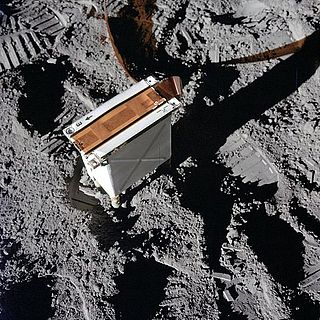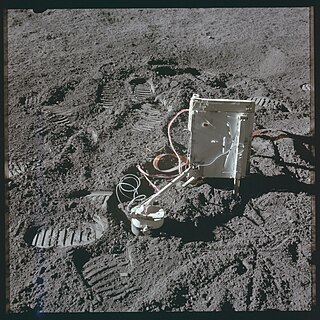
Apollo 12 was the sixth crewed flight in the United States Apollo program and the second to land on the Moon. It was launched on November 14, 1969, by NASA from the Kennedy Space Center, Florida. Commander Charles "Pete" Conrad and Lunar Module Pilot Alan L. Bean performed just over one day and seven hours of lunar surface activity while Command Module Pilot Richard F. Gordon remained in lunar orbit.

Apollo 14 was the eighth crewed mission in the United States Apollo program, the third to land on the Moon, and the first to land in the lunar highlands. It was the last of the "H missions", landings at specific sites of scientific interest on the Moon for two-day stays with two lunar extravehicular activities.

Pressure measurement is the measurement of an applied force by a fluid on a surface. Pressure is typically measured in units of force per unit of surface area. Many techniques have been developed for the measurement of pressure and vacuum. Instruments used to measure and display pressure mechanically are called pressure gauges,vacuum gauges or compound gauges. The widely used Bourdon gauge is a mechanical device, which both measures and indicates and is probably the best known type of gauge.

The Apollo spacecraft was composed of three parts designed to accomplish the American Apollo program's goal of landing astronauts on the Moon by the end of the 1960s and returning them safely to Earth. The expendable (single-use) spacecraft consisted of a combined command and service module (CSM) and an Apollo Lunar Module (LM). Two additional components complemented the spacecraft stack for space vehicle assembly: a spacecraft–LM adapter (SLA) designed to shield the LM from the aerodynamic stress of launch and to connect the CSM to the Saturn launch vehicle and a launch escape system (LES) to carry the crew in the command module safely away from the launch vehicle in the event of a launch emergency.

Explorer 54, also called as AE-D, was a NASA scientific satellite belonging to series Atmosphere Explorer, being launched on 6 October 1975 from Vandenberg Air Force Base board a Thor-Delta 2910 launch vehicle.

The Apollo Lunar Surface Experiments Package (ALSEP) comprised a set of scientific instruments placed by the astronauts at the landing site of each of the five Apollo missions to land on the Moon following Apollo 11. Apollo 11 left a smaller package called the Early Apollo Scientific Experiments Package, or EASEP.

The Lunar Flag Assembly (LFA) was a kit containing a flag of the United States designed to be erected on the Moon during the Apollo program. Six such flag assemblies were planted on the Moon. The nylon flags were hung on telescoping staffs and horizontal bars constructed of one-inch anodized aluminum tubes. The flags were carried on the outside of the Apollo Lunar Module (LM), most of them on the descent ladder inside a thermally insulated tubular case to protect them from exhaust gas temperatures calculated to reach 2,000 °F (1,090 °C). The assembly was designed and supervised by Jack Kinzler, head of technical services at the Manned Spacecraft Center (MSC) in Houston, Texas. Six of the flags were ordered from a government supply catalog and measured 3 by 5 feet ; the last one planted on the Moon was the slightly larger, 6-foot (1.8 m)-wide flag which had hung in the MSC Mission Operations Control Room for most of the Apollo program.

The Apollo 12 Passive Seismic Experiment (PSE) was placed on the lunar surface by the Apollo 12 mission as part of the Apollo Lunar Surface Experiments Package (ALSEP). The PSE was designed to detect vibrations and tilting of the lunar surface and measure changes in gravity at the instrument location. The vibrations are due to internal seismic sources (moonquakes) and external. The primary objective of the experiment was to use these data to determine the internal structure, physical state, and tectonic activity of the Moon. The secondary objectives were to determine the number and mass of meteoroids that strike the Moon and record tidal deformations of the lunar surface.

The Apollo 14 Passive Seismic Experiment (PSE) was placed on the lunar surface on February 5, 1971, as part of the Apollo 14 ALSEP package. The PSE was designed to detect vibrations and tilting of the lunar surface and measure changes in gravity at the instrument location. The vibrations are due to internal seismic sources (moonquakes) and external. The primary objective of the experiment was to use these data to determine the internal structure, physical state, and tectonic activity of the Moon. The secondary objectives were to determine the number and mass of meteoroids that strike the Moon and record tidal deformations of the lunar surface.

The Charged Particle Lunar Environment Experiment (CPLEE), placed on the lunar surface by the Apollo 14 mission as part of the Apollo Lunar Surface Experiments Package (ALSEP), was designed to measure the energy spectra of low-energy charged particles striking the lunar surface. It measured the fluxes of electrons and ions with energies from 40 eV to 20 keV. The primary purpose of the experiment was to examine plasma particles originating from the Sun and the low-energy particle flux in the Earth's magnetic tail.

Explorer 51, also called as AE-C, was a NASA scientific satellite belonging to series Atmosphere Explorer, being launched on 16 December 1973, at 06:18:00 UTC, from Vandenberg board a Delta 1900 launch vehicle.
Explorer 55, also called as AE-E, was a NASA scientific satellite belonging to series Atmosphere Explorer, being launched on 20 November 1975 from Cape Canaveral Air Force Station (CCAFS) board a Thor-Delta 2910 launch vehicle.

The Suprathermal Ion Detector Experiment (SIDE) was a lunar science experiment, first deployed by astronauts on the lunar surface in 1969 as part of Apollo 12, and later flying on Apollo 14 and Apollo 15. The goal of SIDE was to study any potential lunar ionosphere and the solar wind.
The Lunar Atmospheric Composition Experiment (LACE) was a miniature magnetic deflection mass spectrometer. The experiment's aim was to study the composition and variations of the lunar atmosphere. The only deployment of LACE was as part of the Apollo Lunar Surface Experiments Package (ALSEP) on Apollo 17 within the Taurus–Littrow valley.

The Passive Seismic Experiment Package (PSEP) was a scientific experiment deployed on the lunar surface by the astronauts of Apollo 11 as part of the Early Apollo Surface Experiments Package (EASEP). The experiment's goal was to determine the structure, tectonic activity, physical nature, and composition of the Moon. PSEP was the first seismometer to be deployed on a planetary body other than Earth.

The Lunar Surface Magnetometer (LSM) was a lunar science experiment with the aim of providing insights into the interior of the Moon and how its latent magnetic field interacts with the solar wind. It was deployed on the Moon as part of Apollo 12, Apollo 14 and Apollo 16 missions.

The Solar Wind Spectrometer was a scientific package that flew on the Apollo 12 and Apollo 15 missions to the surface of the Moon. The goal was to characterise the solar wind near the Moon's surface and to explore its interactions with the lunar environment. The experiments' principal investigator was Dr Conway W. Snyder of the Jet Propulsion Laboratory.

The Heat Flow Experiment was a lunar science experiment that aimed to measure the rate of heat loss at the surface of the moon. Four experiments were carried on board Apollo missions. Two experiments were successfully deployed as part of Apollo 15 and Apollo 17. The instrument on Apollo 16 was deployed but the cable from it to the ALSEP central station was broken and the experiment was rendered inoperable. A heat flow experiment was carried onboard Apollo 13 but the mission was aborted in-flight and the instrument never reached the surface.

The Lunar Ejecta and Meteorites Experiment (LEAM) was a lunar science experiment that flew to the Moon on board Apollo 17 in 1972. It collected information on dust particles produced as a result of meteoroid impacts on the surface of the Moon.

The Lunar Surface Gravimeter (LSG) was a lunar science experiment that was hoped to find evidence for gravitational waves and to measure the viscoelastic tidal deformation of the Moon by the Earth and Sun. The experiment, which did not work as planned, was deployed on the surface of the Moon by the astronauts of Apollo 17 on December 12, 1972.



















